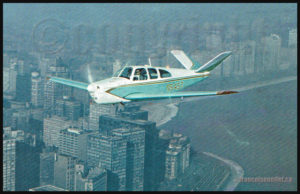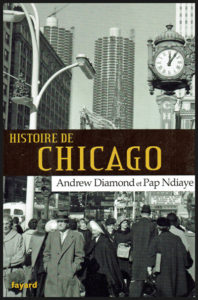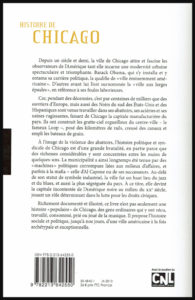The 2016 televised political debates on CNN between Hillary Clinton and Donald Trump put forward the topic of racism in the United States. Chicago was specifically mentioned as it detains the national record for violent deaths. The book “Histoire de Chicago” allows, among other subjects, to better understand what feeds social inequalities between Blacks and Whites since the creation of Chicago.
The reader understands that it is not the cultural deficiencies that are at the base of the problems but an institutionalized racism and the economic choices of the different municipal administrations.
The city grew set against a background in which the color of a person’s skin determined the type of work that he or she was allowed to occupy. Eventually, even urban planning was designed so that Blacks and Whites would be separated: the artificial walls created by the construction of the Dan Ryan Expressway or the Dearborn Park are in themselves good examples.
In 2016, the polls show a strong support for the Unites States republican candidate Donald Trump. Trump knows Chicago very well and he had his “Trump Tower” built there.
The republican candidate takes over in his political platform some of the elements that have made the popularity and success of the Daley family who ruled over Chicago for decades: the exploitation of fear between ethnical groups to build and maintain a political power, the idea of building a wall and the use of torture as a simplistic solution to complex problems.
This populism attracts a certain class of American electors who are easily scared by the differences between people and cultures.
The book “Histoire de Chicago” is very much a reflection of what is happening today and the authors do no fear to raise delicate political subjects.
Chicago
Chicago became a territory of the United States with the Treaty of Paris in 1783. Subsequently, natives progressively lost their lands through different manoeuvers, among them the signature of contracts while they were drunk. Around 1830, when the Indians were definitely gone, the speculative fever started.
Railways
Starting around 1860, Chicago organized itself to become the main hub for the most important railway companies of the United States. The city grew very quickly. Passengers, livestock, cereals and other merchandise had to transit through Chicago. The city depended on the train to grow, and the railway companies depended on Chicago to be profitable.
The rapid growth of Chicago’s population was essentially the driver of migration from Europe (Irish, Germans, Polish and Italians). The evolving and often violent relationships between Chicago’s ethnic groups is well explained in the book.
Retail stores
Just before 1900, the Chicago population witnessed the creation of the first retail stores in which a customer could order through a catalogue and use credit. New categories of employees and managers were added to the working population and helped shape the middle class.
Black immigration in Chicago
Around 1910, there was an important increase in the Black immigration coming from southern United States. Chicago was an abolitionist city. This does not mean that it was favoring racial equality but that it was against slavery. In fact, Chicago progressively became the most segregated city in the United States.
Blacks were massively arriving from southern United States, not only for economic reasons but also to get away from the slavery, racial violence and segregation that was the norm in multiple states. Although far from ideal, the situation in Chicago was better than in the south of the country.
The First World War considerably reduced the number of immigrants coming from Europe. This created a serious problem for a city that was benefiting from numerous military contracts and needed a very high number of employees in its manufacturing companies. This also favored the “great migration”, which is to say “the spectacular intensification of the Afro-American migration towards the North-East and Middle West major urban centers […]” (p.143)
Chicago’s slaughterhouses
Chicago was renowned for the very high number of its slaughterhouses, in particular its pork slaughterhouses. The smell and pollution created by this activity was terrible. Chemical laboratories allowed for the commercial use of all parts of an animal. The writer Georges Duhamel wrote in his book that in Chicago “nothing leaves the slaughterhouse but the squeal” (p.63).
Black workers did not have the right to work in the Chicago steel industry and had to limit themselves to slaughterhouses where they were hired as manual workers. They had no access to qualified jobs.
The Second World War
During the Second World War, Chicago was competing with other major American cities to obtain huge military contracts. The city did not manage its efforts to show it supported the American government. Chicago eventually received billions of dollars for the construction of tanks, tractors, torpedoes, bombs and aircrafts (among them the B-29 bomber aircraft).
To compensate for the lack of manpower, since a lot of men enrolled as volunteers and had gone to war, women massively entered the workforce. Employers saw an opportunity to maximize their profits by reducing the salaries of working women, which corresponded only to 65% of the men’s salary for the same work. This represents the way women were thanked for their effort and collaboration.
Transformation of the Chicago economy

Chicago experienced a profound transformation during the ‘70 s. The closure of the slaughterhouses in 1971, and the diminishing demand for steel mills products signalled the end of the industrial era. It was followed by an opening on the international and the development of a new economy based on specialized services like finance, real estate, insurance, marketing, publicity and legal services.
The Chicago mayor, Richard M. Daley, fostered the establishment of a new socio-professional class of creators in the city (design, arts, music, etc.) by considering it like another “ethnic group” who needed privileged space to express itself.
The development of housing estates and complexes during the ‘60s and ‘70 s
During the ‘60s and ‘70s, the Chicago landscape was profoundly modified. Huge housing estates and complexes were built (Magnificent Mile, Sandburgh Village, Marina City, Lake Point Tower, Dearborn Park) where the White population lived, in the north part of the city. The Chicago Tribune said of Dearborn Park that it was “a fortress reserved for Whites and aimed at protecting the financial district against the Blacks”.
The Daley administration had to fight against urban sprawling and consequently favored the construction of skyscrapers to maintain the presence of Whites in the central area while receiving more property taxes. Two stock exchange institutions were created, the Chicago Board of Trade (CBOT) and the Chicago Mercantile Exchange (CME). The creation of those two institutions as well as of the complexes did not do anything to change the dynamic between the Whites and the Blacks.
The racial segregation
Although Martin Luther King was a dominant figure in the fight for the civil rights of the Blacks in the United States, the authors underline that the black population of Chicago had not waited for a leader to promote their rights as they had already started to mobilize themselves years before.
Martin Luther King’s ideas on the integration of Blacks did not receive the support of everyone in the black community, especially the Chicago black politicians who benefited from a special treatment from the Daley machine, which favored the status quo.
Chicago’s mayor Richard M. Daley experienced much success. To stay in power, the Daley Machine “rested squarely on the continued separation and competition between communities”. (p.322-323) The separation between Blacks and Whites was planned and maintained. There was and there are still two Chicagos.
A highway, the Dan Ryan Expressway, was even positioned in such a way that it would create an artificial wall between the Daley’ s district, Bridgeport and the Black Belt: “This was the most massive obstacle that the city could build, other than a wall, to separate the white South Side from the Black Belt” (p.259).
The Daley Machine
We cannot talk about Chicago without underlining the importance of the Daley family and its political machine: “Through an authoritarian control of the “machine”, Richard J. Daley and his son Richard M. Daley, each one in his own style, dominated the Chicago political scene for forty-three years, between 1955 and 2011.
During that period which saw the development and the subsequent decline of modern civil rights, the ghettoization of huge parts of the West Side and South Side, a massive immigration wave from Latin America and the transformation of the city from an industrial giant to a world-class global services economy center, Chicago barely knew one legitimate municipal election or one real debate at the municipal council” (p.16)
There was rampant corruption and secret budgets in the Daley administration. In total opaqueness, the City Hall diverted the funds reserved to disadvantaged neighbourhood and distributed it to the privileged ones.
“[…] While important businessmen, Mafiosi and others who had links with the Daley machine were getting richer, Blacks and Latinos in need were shot in the street or tortured in the precinct’s’ back rooms” (p.394)
Law firms and entrepreneurs gave huge sums of money in exchange for important contracts. The Daley Machine was never short of money.

Racial tensions and repression policies under Mayor Daley
“By the 1930s, Chicago had become, according to the historian Frank Donner “the national capital for police repression” (p.321)
The black migration that took place during the 1940s and 1950s scared the Chicago population that felt besieged. This increased racial tensions that were already present and maintained. It was easier to accept more policemen than social housing.
The muscled tactics of Mayor Daley were the most obvious during the 1968 Democrat Convention, when policemen and 7000 National Guard soldiers “went down hard on the [crowd of 10,000 young protesters] in an explosion of mindless violence” (p.315)
The exploitation of racial fears was quite successful. Daley was defending his policies by saying that “ most people are more worried about a black uproar than of a mayor that orders the use of lethal force to put an end to it and they recognized themselves far less in pacific protesters than in policemen that hit them with truncheons” (p.319).
Media propaganda and the Daley Machine’s police were efficient in convincing the Blacks to respect the established order. Torture was common in the zone 2’s precinct, in the South Side, between 1972 and 1991.
The expected arrival of a new black mayor, Harold Washington, during the 1980’s, increased the fear that everything would change in Chicago. Everything was done to undermine Washington’s candidacy, but he eventually won helped by the black vote.
There were several left-wing political movements which all had their own objectives and were unable to unite under the same progressist banner. This provided the necessary margin of manoeuver to the Daley Machine, who worked in cooperation with the federal authorities to organize the state repression.
Social problems in disadvantaged neighbourhoods
During the 1995 heat wave, 739 persons died in Chicago. The social precarity helped increase the number of deaths, but it was easier to determine that the victims were responsible of their fate.
The Blacks and Latinos believed, and still do, that the problems related to their school system and neighbourhoods come from some cultural deficiencies, but in trying to understand the real nature of their problems, they overlook the ongoing racism and economic choices of the different city administrations since the creation of the city.
“The 1980 census showed that ten out of sixteen of the poorest neighbourhoods in United States were in Chicago, in the Black Belt, of course”(p.334)
In 2002, Chicago was the American murder capital, with 647 victims. In 2008-2009, the city held the record of students killed in public schools which were gang related.
Today, there are two Chicagos
Today, Chicago benefits from well-defined ethnic neighbourhoods that attract tourists in search of diversity. However, the sustained racial segregation policies have isolated the black neighbourhoods and in 2016 Chicago still has the sad reputation of being the murder capital of the United States.
“The Chicago situation looks more and more like a science-fiction scenario. While part of the city has an economic capacity that sets it among the five first in the world, the other part is frozen in an austerity situation that could very well become irreversible” (p.443)
Title: Histoire de Chicago
Authors: Andrew Diamond and Pap Ndiaye
Editions: Fayard
© 2013
ISBN: 978-2-213-64255-0


